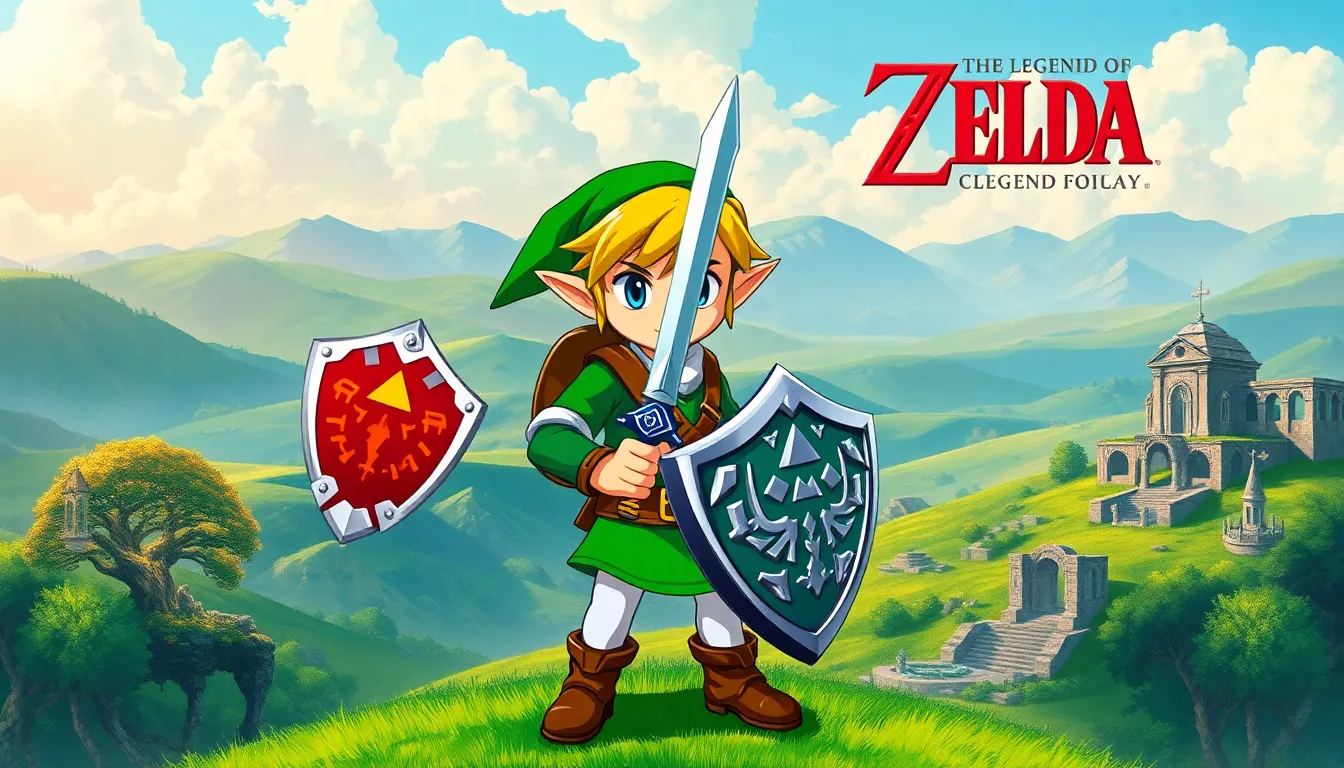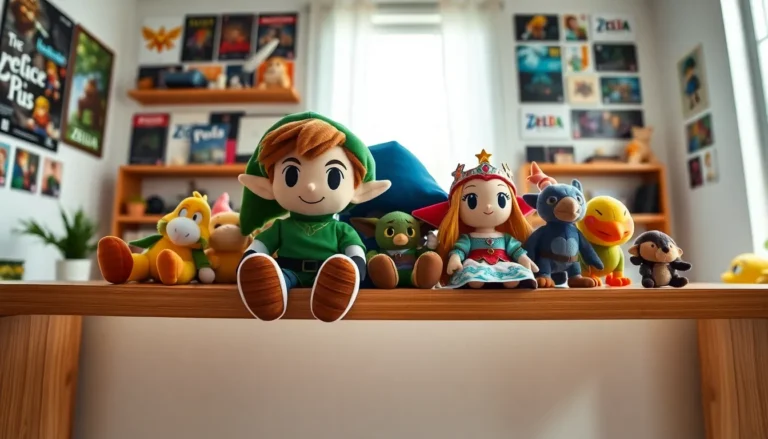Table of Contents
ToggleIn the vast kingdom of gaming, few franchises shine as brightly as The Legend of Zelda. Since its debut in 1986, this beloved series has enchanted players with its captivating tales, intricate puzzles, and memorable characters. Who could forget the heroic Link, forever tasked with rescuing Princess Zelda while battling the forces of evil? It’s like a never-ending game of hide and seek, but with more dragons and less adult supervision.
Overview of Zelda History
The Legend of Zelda franchise began in 1986 with the release of its first title on the Nintendo Entertainment System. This pioneering game introduced players to the expansive kingdom of Hyrule, where they navigated dungeons and solved puzzles. Players took on the role of Link, tasked with rescuing Princess Zelda from the clutches of the evil Ganon.
Subsequent releases built on this foundation, expanding both the gameplay and the series’ lore. “Zelda II: The Adventure of Link,” launched in 1987, introduced side-scrolling elements, while 1991’s “The Legend of Zelda: A Link to the Past” returned to the top-down format and added features like multiple worlds. This title garnered critical acclaim, solidifying the franchise’s status.
The series saw a major evolution with “The Legend of Zelda: Ocarina of Time” in 1998. This game marked the transition to 3D graphics, captivating audiences with its immersive storytelling and innovative mechanics. It set a benchmark for action-adventure games, introducing a lock-on targeting system that became a standard in the genre.
In the 2000s, titles such as “The Legend of Zelda: The Wind Waker” and “The Legend of Zelda: Twilight Princess” showcased different art styles and narrative approaches. Both games received praise and maintained the franchise’s popularity among gamers.
More recent entries like “The Legend of Zelda: Breath of the Wild,” released in 2017, redefined open-world gameplay. It offered unprecedented freedom, allowing players to explore Hyrule in various ways. This innovation proved pivotal in attracting new fans while satisfying long-time players, emphasizing the franchise’s agility in adapting to gaming trends.
Notably, various spin-offs and remakes kept the series relevant in popular culture, emphasizing its place in gaming history. Each title not only maintained the core elements of adventure and exploration but also introduced fresh concepts that continued to engage audiences.
The Origins of Zelda

The origins of The Legend of Zelda lie in the creative vision of Shigeru Miyamoto and his desire to blend exploration with adventure. In 1984, he drew inspiration from his childhood experiences of exploring caves and forests near his home. The goal centered around creating a game that emphasized player freedom and discovery. Unique gameplay mechanics emerged, enabling players to tackle challenges in varied orders. This blend of exploration and puzzle-solving became a defining characteristic of the series.
Designing the First Game
Designing the first game involved groundbreaking ideas and new technology. The open-world concept allowed players to traverse the expansive kingdom of Hyrule freely. A combination of top-down perspective and 8-bit graphics created a unique aesthetic. Players encountered dungeons filled with puzzles and enemies, emphasizing strategic gameplay. The inclusion of items, like the sword and bombs, encouraged creativity in solving challenges. Testing phases revealed the importance of player agency, leading to an innovative design approach.
Release and Reception
The Legend of Zelda debuted on February 21, 1986, in Japan, vintage for its time. Players embraced its adventurous spirit, and the game quickly gained a loyal fanbase. Critics praised its gameplay mechanics and intricate world design, noting how it set a benchmark for future action-adventure titles. Sales figures exceeded expectations, with the game selling over 6.5 million copies worldwide by 2021. Its success catalyzed numerous sequels and spin-offs, establishing Zelda as a landmark franchise in the gaming industry. The initial reception helped solidify The Legend of Zelda’s place in video game history, influencing countless developers and genres.
Major Installments in the Franchise
The Legend of Zelda franchise consists of several key titles that revolutionized gaming and expanded its narrative depth. Each installment contributed uniquely to Hyrule’s lore and gameplay mechanics.
The Legend of Zelda: Ocarina of Time
Released in 1998, Ocarina of Time transformed the action-adventure genre with its innovative 3D gameplay. Players experienced the world of Hyrule through a rich narrative driven by characters and quests. The introduction of Z-targeting allowed for more strategic combat, making battles more engaging. Many players remember the iconic musical mechanics, which played a significant role in puzzle-solving and storytelling. This title received universal acclaim, earning numerous awards and selling over 7 million copies worldwide by 2021, establishing a template adopted by numerous future games.
The Legend of Zelda: Breath of the Wild
Breath of the Wild launched in 2017 as a landmark entry in the franchise. Set in an expansive open world, this title redefined exploration and player freedom. Gamers appreciated the interactive environment, where they could employ physics in creative ways to solve puzzles. The detailed chemistry system introduced new elements to gameplay, encouraging experimentation. With over 30 million copies sold globally, Breath of the Wild attracted both seasoned fans and newcomers alike, receiving awards for its groundbreaking design and expansive gameplay mechanics.
Evolution of Gameplay and Mechanics
The evolution of gameplay and mechanics in The Legend of Zelda franchise reflects its innovative spirit and adaptability. Each title introduced new elements that reshaped how players interact with the game world.
Technical Advances Over Time
Technical advancements significantly enhanced gameplay throughout the series. The transition from 8-bit graphics in the original game to 3D graphics in Ocarina of Time marked a pivotal moment. Released in 1998, Ocarina of Time showcased Z-targeting, revolutionizing combat dynamics. Later, Breath of the Wild pushed boundaries of open-world design, offering unprecedented player freedom. The introduction of physics-based mechanics and a chemistry system allowed for innovative problem solving. Such advances set industry standards and inspired numerous game developers to implement similar features in their titles.
Impact on Gaming Culture
The Legend of Zelda series has left a profound mark on gaming culture. Iconic themes and memorable characters, particularly Link and Princess Zelda, resonate with fans worldwide. Gameplay mechanics, such as puzzle-solving and exploration, inspire countless other games across various genres. As players engage in quests and share experiences, a strong community has formed around the franchise. Events like The Legend of Zelda Symphony concert series further celebrate its cultural significance. This enduring influence on pop culture underscores the franchise’s pivotal role in shaping modern gaming experiences.
Spin-offs and Related Media
The Legend of Zelda franchise extends beyond video games, captivating audiences through various spin-offs and related media.
Zelda Comics and Novels
Comics and novels based on Zelda enrich the franchise’s lore, allowing fans to explore stories in a different format. Notable examples include the “The Legend of Zelda: Ocarina of Time” manga series, created by Akira Himekawa. This series presents character-driven narratives and detailed illustrations that expand on in-game events. Additionally, novels like “The Legend of Zelda: Hyrule Historia” provide fans with comprehensive histories and artwork from the series, appealing to both new and longtime enthusiasts. The fusion of different media deepens the connection between fans and the beloved characters.
Animated Series and Merchandise
The animated series, titled “The Legend of Zelda,” aired briefly in 1989, featuring Link’s adventures in Hyrule. Its distinct animation style gave the franchise a new visual identity, introducing the characters to a wider audience. Merchandise, including toys, apparel, and collectibles, further engages fans and celebrates their passion for the series. The range of products caters to diverse interests, ensuring advancements in popular culture. Through these spin-offs, The Legend of Zelda continues to capture imaginations across multiple platforms.
The Legend of Zelda franchise stands as a monumental achievement in gaming history. Its blend of exploration storytelling and innovative gameplay has created a timeless experience that resonates with players of all ages. Each installment not only builds on the legacy of its predecessors but also pushes the boundaries of what games can achieve.
As the series continues to evolve it remains a beacon of creativity inspiring new generations of gamers and developers alike. The community surrounding Zelda thrives through shared passion and celebration of its rich lore and iconic characters. This enduring legacy ensures that The Legend of Zelda will remain a beloved cornerstone of gaming culture for years to come.




